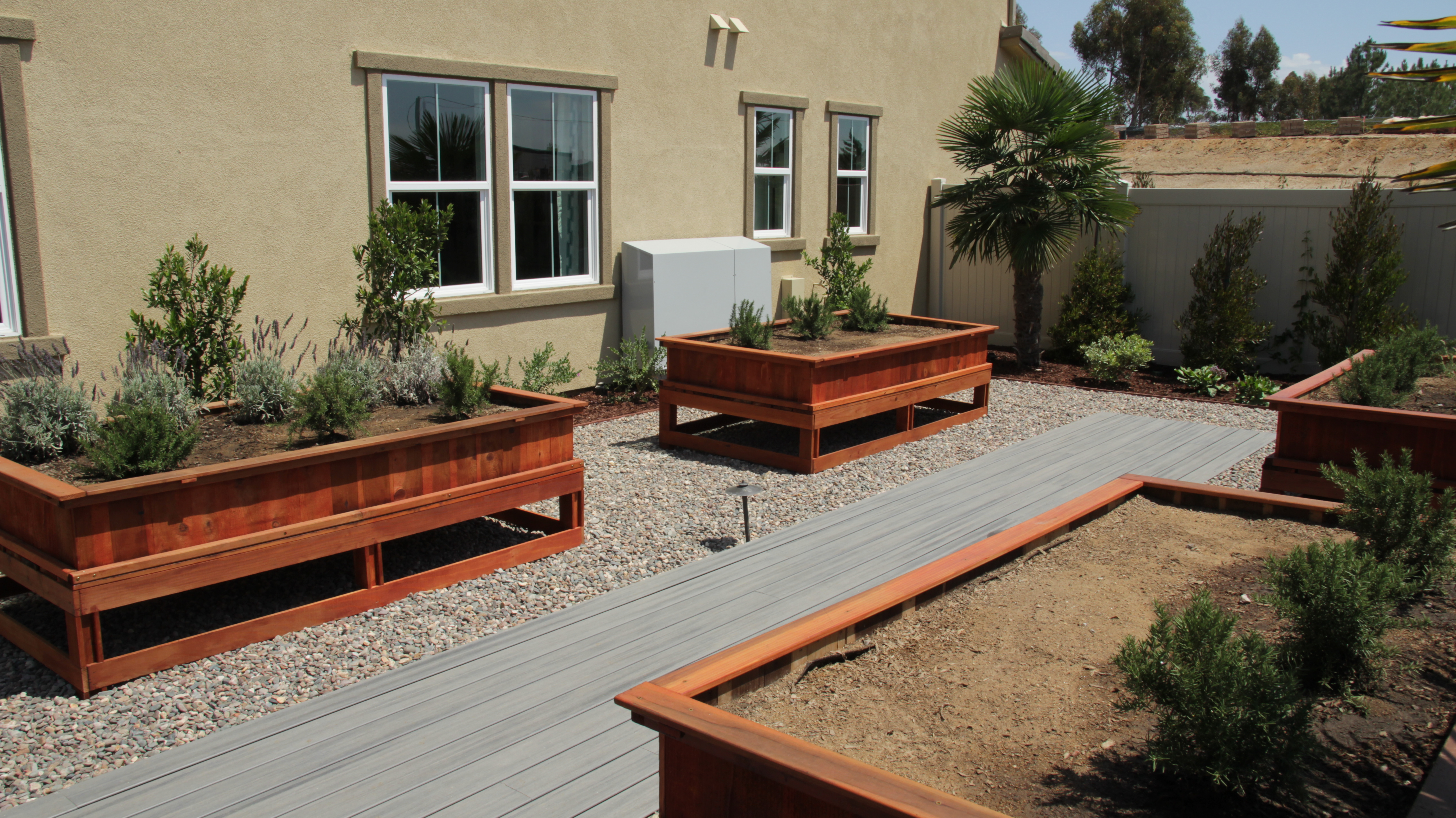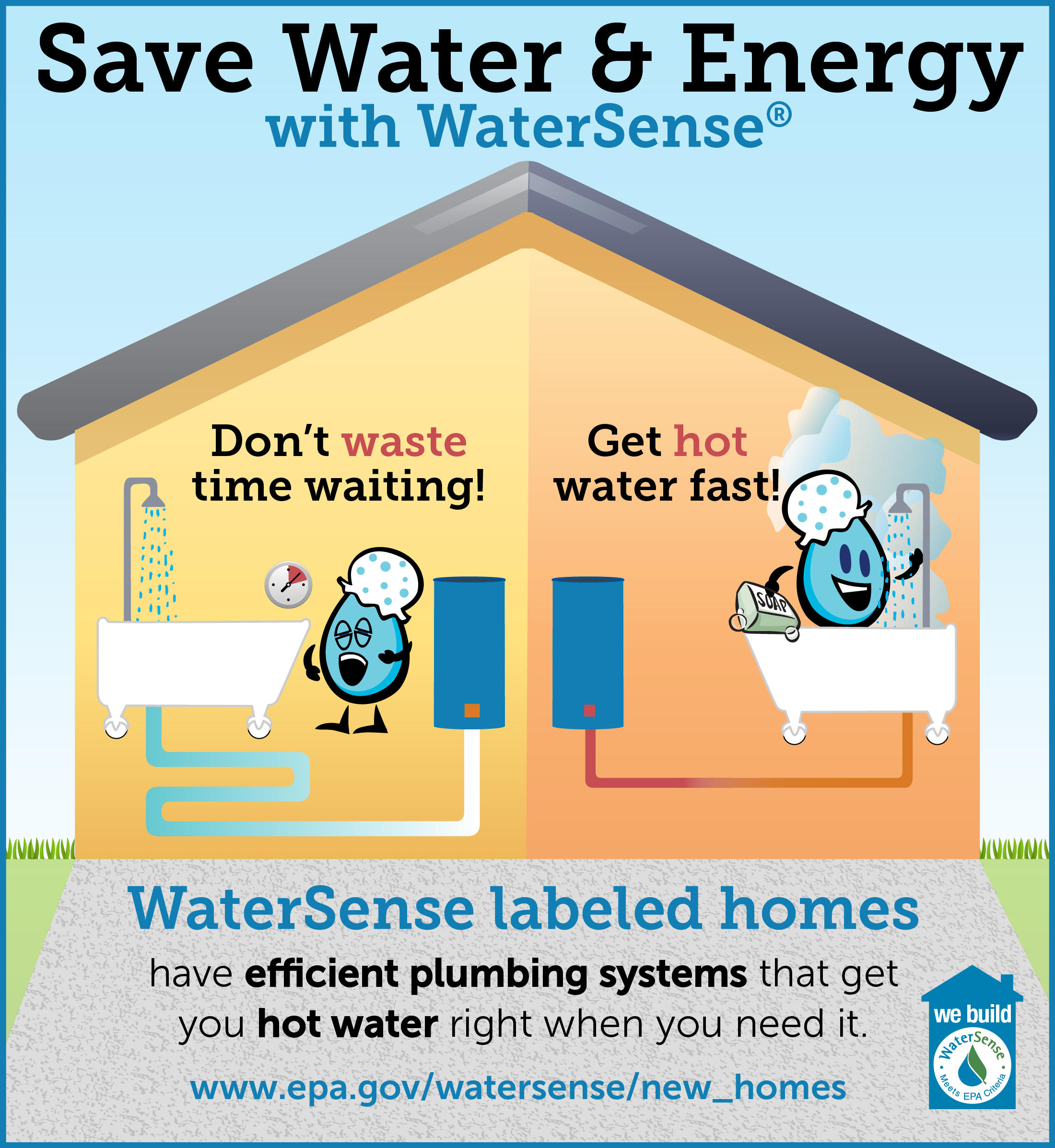The WaterSense Blueprint
The WaterSense Blueprint: Issue VIII, Winter 2016
The WaterSense Blueprint is a quarterly update dedicated to news and events related to WaterSense labeled new homes. Sign up to receive The WaterSense Blueprint and get WaterSense news delivered right to your Inbox. You can also help spread the word by distributing Blueprint (4 pg, 428K, About PDF) to builders and developers looking to incorporate water efficiency into their projects. If you missed any of our previous issues, you can find them in our Blueprint Archives.
In This Issue:
- Technical Corner: Going Beyond the WaterSense Label with Graywater Reuse
- Marketing Corner: Water-Energy Nexus Hits Home With Winter Chill
- In the News
- Calendar of Events
In This Issue
As autumn comes to a close, it's time to look ahead to a new year. In the forward-thinking spirit, this issue's "Technical Corner" features a growing solution to complement traditional home water supply sources—graywater reuse. The approaching seasonal weather change often means more energy use at home, but our “Marketing Corner” highlights ways to cut energy use by saving hot water.
Learn more about home water efficiency news in our “In the News” section, and peruse our “Calendar of Events” for upcoming items of interest.
We want the Blueprint to cover the topics you’re most interested in, so please don’t hesitate to let us know what future topics you’d like us to address. Email those and other comments to watersense@epa.gov.
Technical Corner: Going Beyond the WaterSense Label with Graywater Reuse
The ongoing drought in the western part of the country has focused attention on long-term water supply challenges, highlighting the need to conserve and increase drought resiliency. Time and again, regions are turning to water efficiency to help extend the life of their existing water supply. WaterSense labeled homes are part of this solution, doing more with less through water-efficient and high-performing fixtures, plumbing design, landscapes, and irrigation systems. Though increasing efficiency is a great way to save water, some builders are going even further by incorporating alternate water sources, such as graywater reuse, into their new construction. Graywater reuse complements water efficiency efforts to cut potable water use even more.
While the regulatory definition varies from state to state, gray water is generally understood to be gently used household wastewater from bathroom sinks, bathtubs, showers, washing machines, and dehumidifiers. Gray water does not include wastewater from toilets or kitchens, which is instead considered “black water.” With reuse applications both inside and outside the home, gray water is becoming increasingly recognized as a safe solution to reduce the burden on traditional water supply sources.
In a graywater recycling system, that gently used household wastewater that is normally discharged for municipal sewage treatment is collected, treated, and distributed for reuse on site. Outdoors, gray water can irrigate lush landscapes or fill ornamental ponds. Inside, it can be used to flush toilets in some locations. Once the graywater system is in place, it will work automatically with little active management, reducing potable water use by 16 to 40 percent, depending upon the home. In fact, graywater recycling can make it possible to reuse up to two of every three gallons of water used indoors.
The major components of a graywater recycling system include:
- Dual plumbing that collects gray water from sinks, showers and laundry
- Water storage tanks, which should be closed to minimize contact
- Color-coding to identify piping as a graywater source
- A treatment system to filter and disinfect water if required
- Pumps to move the water
- Controls
For builders interested in incorporating graywater reuse into their projects, the first step is to dual plumb the home with a second set of discharge pipes to make it “recycling ready.” This dual plumbing provides a channel to collect gray water separately from black water and should be color-coded to identify it as a graywater source. These pipes flow to a storage tank prior to treatment.

Nexus eWater system at work in a WaterSense labeled home within KB Home's Sea Cliff community in San Diego, California.
Next, builders can select a treatment system solution. A number of companies are
working to perfect onsite treatment solutions so that a majority of water used inside the house can be recycled for a second use. For example, some WaterSense labeled homes in San Diego’s Sea Cliff community![]() feature the Nexus eWater system
feature the Nexus eWater system![]() , which treats gray water and helps further reduce potable water use at Sea Cliff.
, which treats gray water and helps further reduce potable water use at Sea Cliff.
Remember, graywater systems must always be site-appropriate and meet state and local regulations. When adding a graywater system to a project, consider the following:
- Check all pertinent state and local regulations, as well as with your local wastewater utility, to ensure a graywater system is appropriate for your site.
- Prevent opportunities for human contact with untreated gray water or soil irrigated with untreated gray water.
- Ensure that gray water remains on site and does not run off the homeowner’s property.
- Avoid spray irrigation for lawns and landscapes—spraying gray water is prohibited in most states.
- If rehabbing homes with slab foundations, plan accordingly. Recoverable gray water might be limited to washing machine discharge because most drain pipes, such as those for sinks, are buried beneath the slab and aren’t easily accessible without significant expense. The best candidates for graywater retrofits are homes with raised foundations or basements.
- Look for eligible incentives. Graywater retrofits might be eligible for property-assessed clean energy financing and other financial assistance.
If you have questions about graywater regulations in your area, contact your state environmental regulatory agency. As a reminder, the WaterSense new home specification does not require alternative water sources, including graywater systems, in WaterSense labeled homes. Additionally, graywater recycling equipment is not eligible for the WaterSense label at this time. Nevertheless, graywater reuse remains an option to go beyond the WaterSense label for a more drought-resilient, water-efficient home.
Marketing Corner: Water-Energy Nexus Hits Home During Winter Chill
Winter inevitably increases heating costs for many Americans, but homeowners with water-efficient houses can offset some of those bills even as the mercury drops. With WaterSense labeled homes, your customers don’t just save water—they save energy and money too.
Heating water for showering, bathing, shaving, cooking, and cleaning requires a considerable amount of energy. Homeowners with electric water heaters, for example, spend one-quarter of their total electric bills just to heat water. WaterSense labeled homes take advantage of opportunities to save by featuring water-efficient fixtures and an effective hot water distribution system, cutting a family of four’s energy use by more than 1,000 kilowatt-hours each year.

View the Shower Better animated video.
A no-brainer way to save both water and energy is using water-efficient, WaterSense labeled products,which is why all WaterSense labeled homes include them. Showerheads offer the biggest bang for your buck. With WaterSense labeled showerheads, homeowners can have the satisfying shower they want with the added benefit of saving water, energy, and money. All WaterSense labeled products are independently certified to perform well—in this case, showers will provide the spray force and water coverage consumers have come to expect. WaterSense’s new Shower Better video![]() shows off the benefits of using WaterSense labeled showerheads, including significant water and energy savings.
shows off the benefits of using WaterSense labeled showerheads, including significant water and energy savings.
During cold winter months, long waits for hot water are also a common homeowner complaint. In fact, the average home wastes approximately 3,650 gallons of water per year waiting for hot water to reach the tap. That’s why WaterSense made sure to require efficient hot water distribution as part of earning the WaterSense label for a home. Hot water delivery systems in WaterSense labeled homes are designed to bring homeowners hot water faster so they don’t waste water—or energy—while waiting for a scrub or a hot bath tub.

The length of piping between the water heater and each fixture, the pipe diameter, and the pipematerial can all impact the efficiency of hot water delivery. To help builders and plumbers plan and implement efficient plumbing systems, WaterSense’s Guide for Efficient Hot Water Delivery Systems describes potential design considerations, including example efficient plumbing design layouts. We encourage you to dig deeper into this important home feature!
WaterSense labeled homes increase customer satisfaction with water- and energy-efficient plumbing systems that cut hot water delivery times and utility bill costs. Using this Efficient Hot Water Distribution Infographic (shown at right) is an easy way to communicate the benefits.
In the News
Calendar of Events
January 2016: WaterSense Partner Annual Reporting Launch
Attention WaterSense partners: Make sure to complete your annual reporting requirements![]() . Through WaterSense annual reporting, you can celebrate your accomplishments in 2015 while providing WaterSense with valuable feedback to help improve the program. All partners that submit an annual reporting form are eligible to apply for a Partner of the Year Award,
. Through WaterSense annual reporting, you can celebrate your accomplishments in 2015 while providing WaterSense with valuable feedback to help improve the program. All partners that submit an annual reporting form are eligible to apply for a Partner of the Year Award,![]() which recognizes WaterSense partners that go above and beyond to support WaterSense and promote water efficiency.
which recognizes WaterSense partners that go above and beyond to support WaterSense and promote water efficiency.
January 29, 2016: Q4 2015 WaterSense Quarterly Reporting Deadline
It’s almost time for licensed certification providers to report to WaterSense on any homes that earned the WaterSense label during the fourth quarter (Q4) of 2015. The Q4 2015 reporting deadline is Friday, January 29, 2016.
February 29-March 2, 2016: RESNET Building Performance Conference
Scheduled for February 29 to March 2, 2016, in Scottsdale, Arizona, the 2016 RESNET
Performance Conference![]() is a national forum on home energy ratings, residential energy efficiency financing, and building performance business development. In addition to presenting at several educational sessions, WaterSense will be exhibiting, so stop by and say hello!
is a national forum on home energy ratings, residential energy efficiency financing, and building performance business development. In addition to presenting at several educational sessions, WaterSense will be exhibiting, so stop by and say hello!
March 22-24: 2016 NFMT Conference and Expo
The National Facilities Management and Technology (NFMT) Conference and Expo![]() will take March 22 to 24, 2016, at the Baltimore Convention Center in Baltimore, Maryland.
will take March 22 to 24, 2016, at the Baltimore Convention Center in Baltimore, Maryland.




